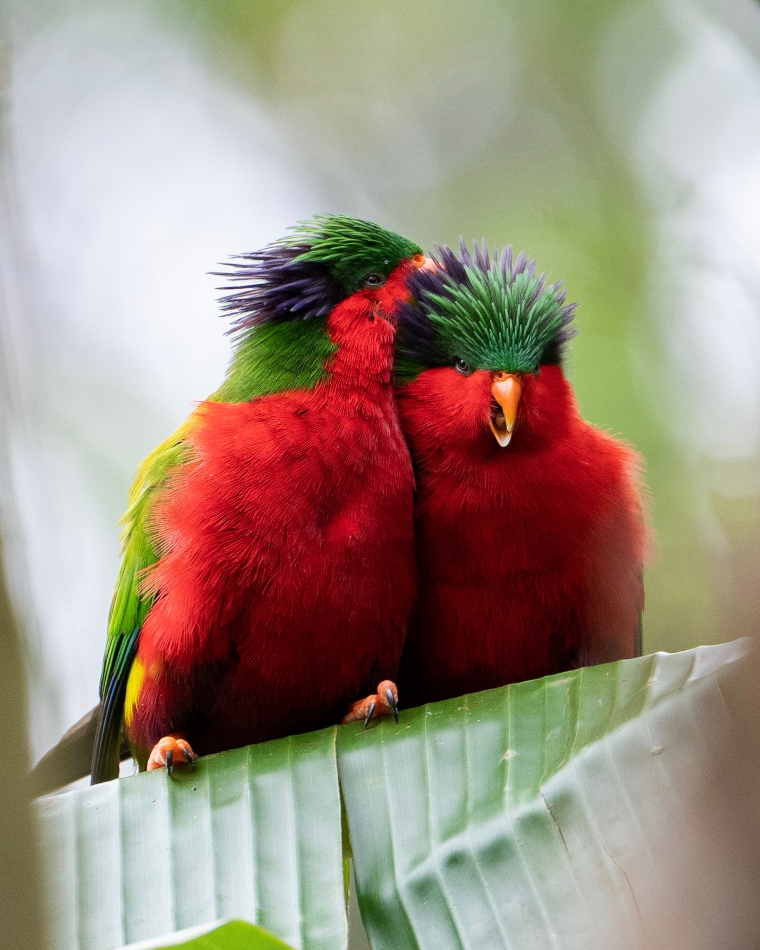Kuhl's Lorikeet certainly qualifies as one of the gems of the bird world. But precisely because of its vibrant multicoloured plumage, this small, fast-flying Pacific lorikeet became extinct from at least five of the southern Cook Islands, most likely due to excessive exploitation for its red feathers to adorn Polynesian ceremonial headdresses. Such feather use no longer occurs, but Kuhl's Lorikeet is still classified as Endangered, mainly from the potential colonisation of islands by black rats, which predate eggs and chicks.

Kuhl's Lorikeet was once killed in numbers for its red feathers, used to decorate ceremonial headwear (Desertnaturalist).
Until 2007, Kuhl's Lorikeets were present on four islands: Rimatara in French Polynesia, and Teraina, Tebuaeran and Kiritimati islands further north in Kiribati. Collectively these islands offer a land area of about 438 sq km spread across a few million sq km of ocean, and it is thought that long ago Polynesians brought lorikeets to the islands in Kiribati, and there is a report of an introduction to Kiritimati in 1957. The most recent numbers reported from these islands are 835 on Rimatara, 1,000 on Teraina, 50 on Tabuaeran and only a few on Kiritimati. Tabuaeran is the only island confirmed to have Black Rats, although feral cats could pose a threat on Kiritimati.

Aerial view of Ātiu island (Desertnaturalist).
Due to the ever-present possibility that Black Rats could colonise Rimatara, through a project in 2007 for the deliberate translocation of 27 Kuhl's Lorikeets a fifth island became (re-)inhabited by the species, the 29-sq-km island of Ātiu in the southern Cook Islands. The Loro Parque Fundación contributed funds to the San Diego Zoological Society, which was the advisory technical organisation for the translocation, working in conjunction with the Ornithological Society of Polynesia (BirdLife International Partner in French Polynesia), Te Ipukarea Society (BirdLife Affiliate in the Cook Islands) and the Cook Islands Natural Heritage Trust, which co-ordinated the project. The translocation not only had the support of the governments of French Polynesia and the Cook Islands, but also the blessing of the people of both islands without which, according to Gerald McCormack, director of the C I Natural Heritage Trust, the project could not have happened.
Ātiu, also called Enuamanu or the land of the birds, is similar in several ways to Rimatara. They are both raised islands of low central volcanic hills, surrounded by discontinuous swampland, all of which is encircled by an uplifted rim of coral reef limestone, called makatea. On both islands native forest flourishes on the makatea, the inland hills are covered with native ferns and exotic forests and the fertile lower slopes and valleys are given over to horticulture. The native plants and the introduced plants of the two islands are very similar. One obvious and important difference is that Ātiu is twice as wide and more than three times the area of Rimatara.

Control of non-native Common Mynas has contributed to the success of conservation efforts (Creepanta).
Soon after arrival on Ātiu, the 27 transferred lorikeets, all ringed, were released and could be observed in noisy flocks of up to 16 traversing the island. During the first years the project partners of the Cook Islands worked with Ātiu residents to map the location of all transferred birds, locate breeding sites, and to identify any problems and develop solutions. One big incentive was a $200 prize for the first fledgling sighted, and photographed as confirmed by George Mateariki. George is an Ātiu resident who has turned out to be pivotal in the protection and monitoring of the lorikeets, with his never-ending vigilance at the harbour and airstrip to keep Black Rats off the island and dedication to the control of another introduced alien species, Common Myna. In 2017 the Critical Ecosystem Partnership Fund recognised 'Birdman George' as 'hero' for Polynesia and Melanesia, being one of only 15 people around the world similarly honoured for their work in ecological hotspots.

A total of 27 Kuhl's Lorikeets were translocated to Ātiu, with reward money put forward for the first evidence of a fledged juvenile (Kirbymorejohn).
On 21 February 2008, the first juvenile Kuhl's Lorikeet was seen and photographed, but giving prizes had to wait until 22 June, when the first active nest was found. This was located inside a cyclone-damaged trunk of an albizia tree, about 9 m off the ground, and two chicks eventually fledged from the nest. The next nest was found in August of the same year. The breeding was great news but there was an immediate downside. Common Mynas (with a population of up to 7,000 individuals) attacked lorikeet chicks as they emerged from the nests and persistently harassed all lorikeets to the extent of posing a threat to the successful establishment of a new population the lorikeet on Ātiu.
To save the endangered Kuhl's Lorikeet on Ātiu from the aggressive Common Mynas, introduced in 1915 with the intention to control numbers of coconut-stick insects, the decision was taken to reduce the population of the mynas on the island, or perhaps to eliminate it entirely. The reduction measures were initiated in 2009 and progressed in several stages as the dwindling mynas were increasingly difficult to locate. However, the people of Ātiu were insistent that their island should become free of mynas, which were neither friend of native species nor farmer, and therefore the control measures continued until successful eradication was declared in 2016.
With this threat removed the population of the Kuhl's Lorikeet, or Kura as it is known on Ātiu, has rapidly expanded. The species is principally a nectar-feeder, and Ātiu offers widespread and abundant sources of food. In 2017 the lorikeet's population was estimated at 385 individuals, but reports from the past two years indicate that it could now be between 400 and 500. What a welcome success story this is!

